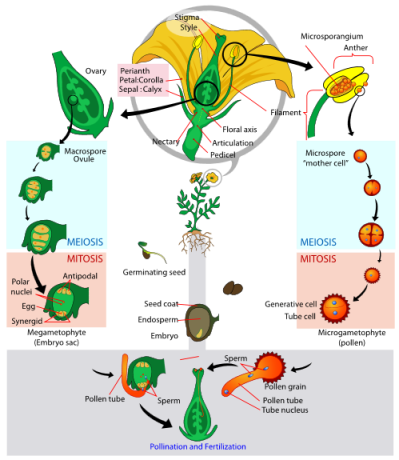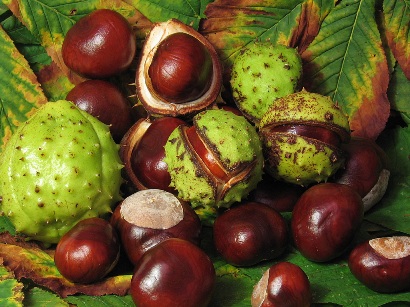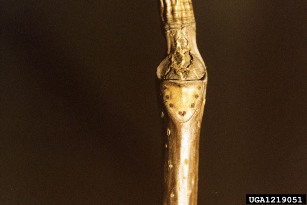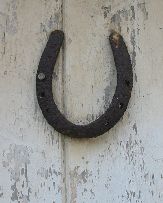Reproduction
The reproductive means of the Aesculus hippocastanum
can be summarized by the three "Fs": The structure and function
of the flower, the
fertilization process, and the
fruit form and function.
 FLOWER -
FLOWER -
Flowers are the main reproductive organ of any angiosperm.
In the horse chestnut, the flowers are arranged in
inflorescences. This means that multiple flowers are
grouped together into clusters. Each flower contains
stamen, carpel(s), sepals, and petals. Sepals protect the
bud before it blooms and the petals attract pollinators to the
flower. Horse chestnut petals are white with red and/or yellow
centers. Each stamen consists of a pollen producing anther atop
a supportive filament. The pollen contains the male
gametophyte of the plant. Each carpel consists of a sticky
stigma connected to an ovary containing ovules by a slender neck
called the style. The ovule is the sight of the
development of the female gametophyte in the plant.
Pollen can be transported for the anther to the sticky stamen in
a huge variety of ways. These methods of transfer can be
divided into two different types,
abiotic and
biotic. The
majority of angiosperms rely heavily on the biotic factors, such
as through bees, moths, birds, flies, and bats. However,
horse chestnuts are known to rely on the only major abiotic
method; wind. They make up for the inefficiency of
wind-dissemination by creating a large quantity of flowers and
consequently pollen.
FERTILIZATION -
The development of the male gametophyte occurs
primarily within the anther. The anther begins by
containing diploid microsporocytes. These cells undergo
meiosis to produce four haploid microspores. Each of these
cells develop into a pollen grain.
 After
the pollen grain lands on the stigma of the
carpel the male gametophyte within will divide its nucleus to
create two sperm. The development of the
female gametophyte occurs within the ovule. The ovule
starts by containing a megasporocyte, otherwise known as the
megaspore mother cell. This undergoes meiosis to give rise
to four haploid cells, much like the male gametophyte
development. However, only one of these will develop into
the megaspore and the others simply disintegrate. This
megaspore then undergoes mitotic division three times without
any type of
cytokinesis. This results in a very large cell
with eight haploid
nuclei. Membranes then form to fully develop this into the
embryo sac. This mature embryo sac
contains one egg, two synergids to guide the pollen, three
antipodal cells, and two polar nuclei.
After
the pollen grain lands on the stigma of the
carpel the male gametophyte within will divide its nucleus to
create two sperm. The development of the
female gametophyte occurs within the ovule. The ovule
starts by containing a megasporocyte, otherwise known as the
megaspore mother cell. This undergoes meiosis to give rise
to four haploid cells, much like the male gametophyte
development. However, only one of these will develop into
the megaspore and the others simply disintegrate. This
megaspore then undergoes mitotic division three times without
any type of
cytokinesis. This results in a very large cell
with eight haploid
nuclei. Membranes then form to fully develop this into the
embryo sac. This mature embryo sac
contains one egg, two synergids to guide the pollen, three
antipodal cells, and two polar nuclei.
This sets the stage for the fertilization that occurs.
The synergids attract the sperm down the style to the ovule
containing the egg. At this point one sperm fertilizes the
egg producing a dipoid zygote. Then what is the other
sperm for? This combines with the two polar nucli inside the
ovule. This creates a tripoid cell to eventually give rise
to the endosperm. Because of this two sperm
fertilization, this process is coined double
fertilization.
 FRUIT -
FRUIT -
The horse chestnut fruit presents with a spiny exterior
containing 1-3 seeds or conkers. Within this fruit the
triploid cell in the ovule develops into the endosperm before the
embryo develops. Then the zygote begins developing into an
embryo within the two cotyledons that eventually develop into
the first leaves of the tree. As this is such an important
part of the plant, plants utilize many methods to spread these
seeds far and wide. Some methods of dispersal is via
water, wind, and animals. The horse chestnut potentially
uses all of these methods except for wind. Though wind
could have a small impact on the end location of the seeds, it
would have very little effect on the heavy seeds produced by the
horse chestnut. Therefore, if the trees are not placed by
a body of water, they primarily spread their seeds through
animals.

